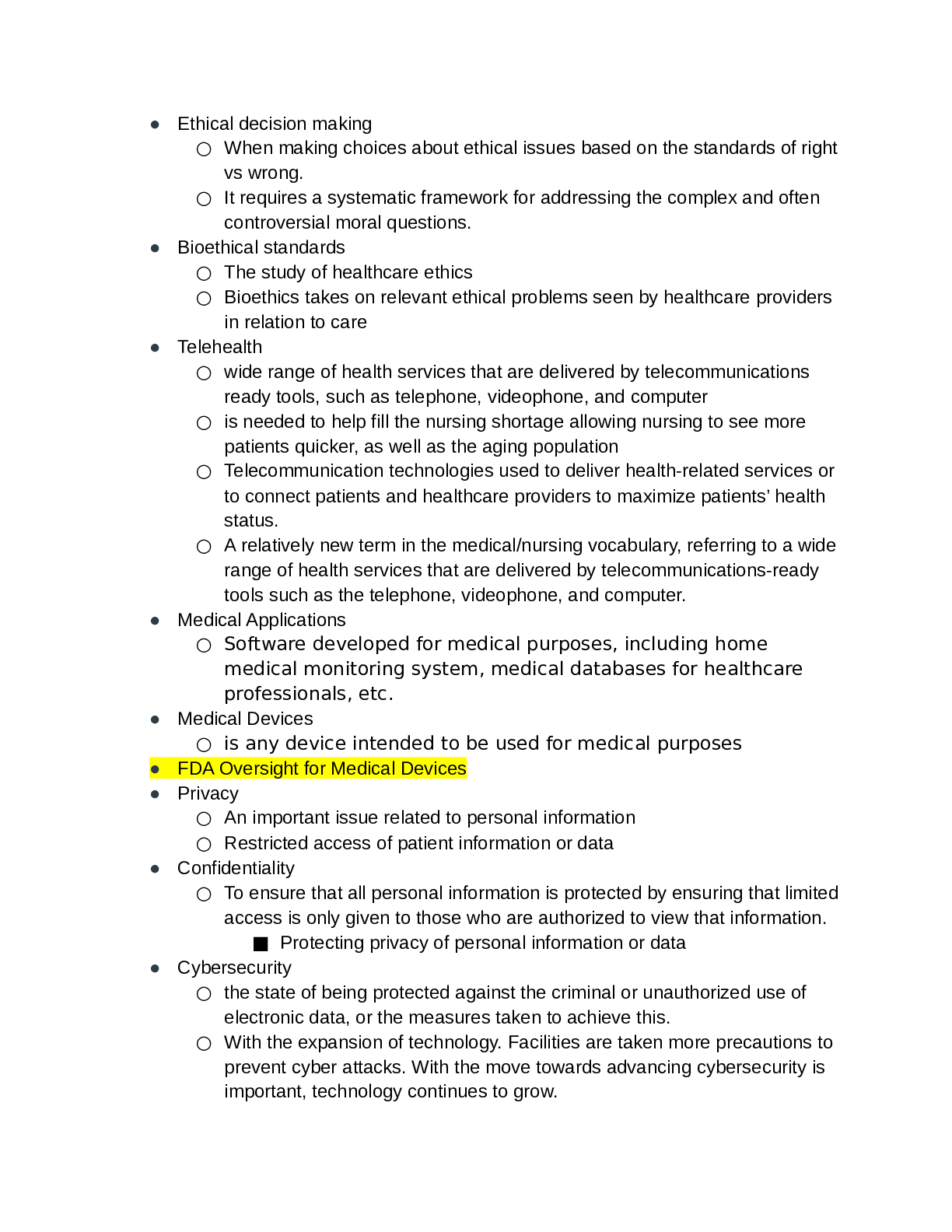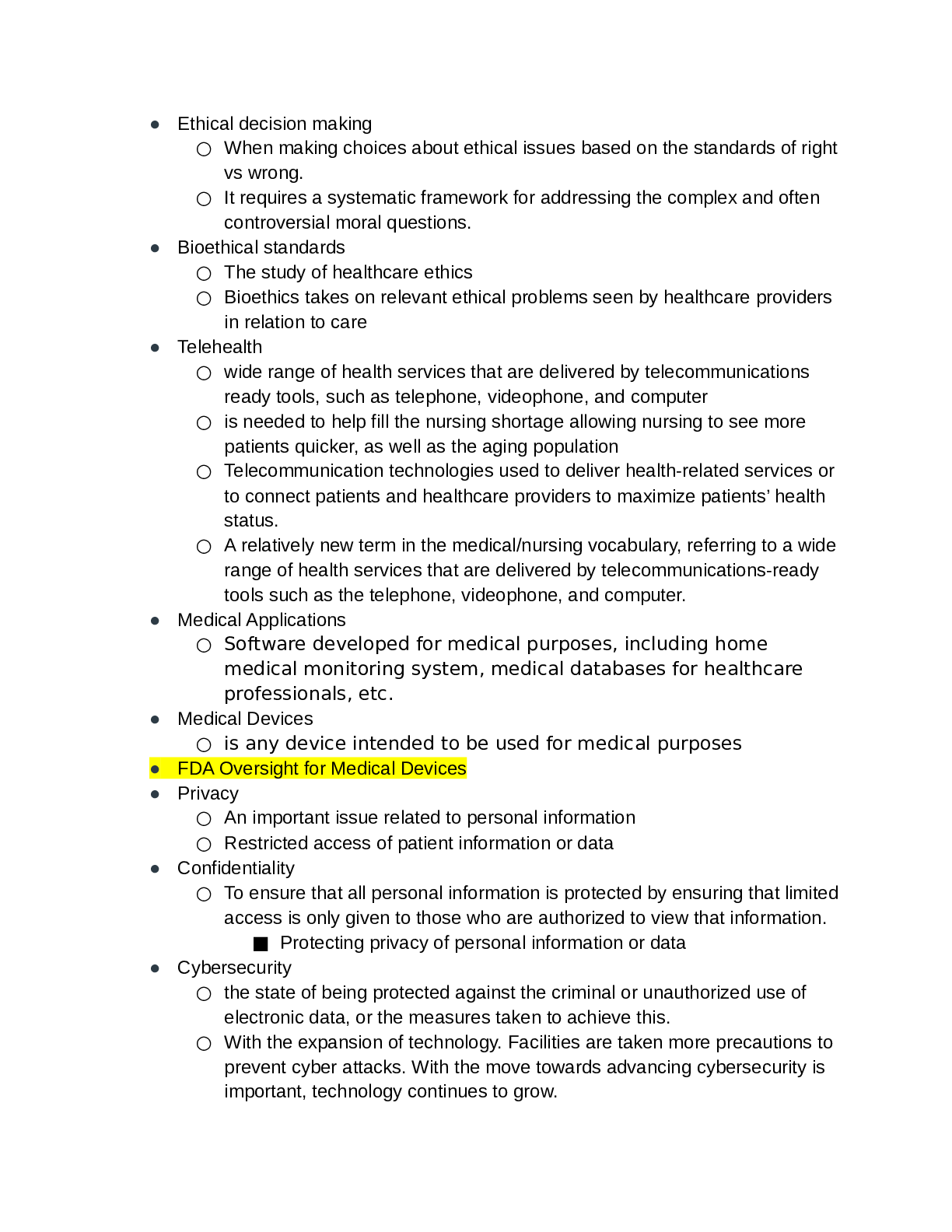Ethical decision making
○ When making choices about ethical issues based on the standards of right
vs wrong.
○ It requires a systematic framework for addressing the complex and often
controversial moral questions.
● Bioethical standards
○ The study of healthcare ethics
○ Bioethics takes on relevant ethical problems seen by healthcare providers
in relation to care
● Telehealth
○ wide range of health services that are delivered by telecommunications
ready tools, such as telephone, videophone, and computer
○ is needed to help fill the nursing shortage allowing nursing to see more
patients quicker, as well as the aging population
○ Telecommunication technologies used to deliver health-related services or
to connect patients and healthcare providers to maximize patients’ health
status.
○ A relatively new term in the medical/nursing vocabulary, referring to a wide
range of health services that are delivered by telecommunications-ready
tools such as the telephone, videophone, and computer.
● Medical Applications
○ Software developed for medical purposes, including home
medical monitoring system, medical databases for healthcare
professionals, etc.
● Medical Devices
○ is any device intended to be used for medical purposes
● FDA Oversight for Medical Devices
● Privacy
○ An important issue related to personal information
○ Restricted access of patient information or data
● Confidentiality
○ To ensure that all personal information is protected by ensuring that limited
access is only given to those who are authorized to view that information.
■ Protecting privacy of personal information or data
● Cybersecurity
○ the state of being protected against the criminal or unauthorized use of
electronic data, or the measures taken to achieve this.
○ With the expansion of technology. Facilities are taken more precautions to
prevent cyber attacks. With the move towards advancing cybersecurity is
important, technology continues to grow.
○ Ensure all systems are adequately protected and patients remain safe
from harm
○ NI are frequently called on to evaluate the safety and effectiveness of new
devices and software.
● Computer-aided translators
○ is a form of language translation in which a human translator uses
computer hardware to support and facilitate the translation process.
● HIPPA
○ was established in the U.S. in 1996 to protect an individual's
personal health care information.
○ Signed by Pres. Bill Clinton
○ Healthcare institutions are required to meet all standards and
comply with the appropriate security measures in order to
safeguard patient data.
○ Four parts to HIPAA's Administrative Simplification
■ Electronic transactions and code sets standards
requirements.
■ Privacy requirements.
■ Security requirements.
■ National identifier requirements.
● ICD-10 Coding
○ An alphanumeric code used by doctors, health insurance
companies, and public health agencies across the world to
represent diagnoses.
○ The system offers accurate and up-to-date procedure codes to
improve health care cost and ensure fair reimbursement policies
○ The current codes specifically help healthcare providers to
identify patients in need of immediate disease management and
to tailor effective disease management programs.
■ Similarly ICD and CPT coding go together
● Is a medical code set that is used to report medical,
surgical, and diagnostic procedures and services to
entities such as physicians, health insurance
companies and accreditation organizations.
● Evaluation and Management Coding
○ Is a medical coding process in support of medical billing
○ Practicing health care providers in the United States must use E/M coding
to be reimbursed by Medicare, Medicaid programs, or private insurance
for patient encounters.
● Reimbursement Coding
○ Is based on claims and documentation filed by providers using
medical diagnosis and procedure codes.
○ Commercial payers must use standards defined by the U.S.
Department of Health and Human Services (HHS) but are largely
regulated state-by-state.
● Clinical Support Tools
○ are designed to help sift through enormous amounts of digital
data to suggest next steps for treatments, alert providers to
available information they may not have seen, or catch potential
problems, such as dangerous medication interactions
○ Such as CDS clinical decision support, a program used by
providers.
○ Or various applications use by healthcare professionals to allow
for communicate between provider to provider and provider to
patient
○ The tools are all used to benefit patient outcome
● Workflow analysis
○ Not an optional part of clinical implementations, but rather a necessity for
safe patient care fostered by technology.
○ The ultimate goal of workflow analysis is not to “pave the cow path,” but
rather to create a future-state solution that maximizes the use of
technology and eliminates non–value-added activities.
○ Although many tools and methods can be used to accomplish workflow
redesign, the best method is the one that complements the organization
and supports the work of clinicians.
○ needs to be done as well as working in optimization (moving conditions
past their current state into a more effective method of performing.
WEEK FIVE READING/ KEY POINTS
Key points from the lessons and modules
● Clinical Decision Support (CDS)
○ Generate patient specific interventions, assessments and
recommendations
○ CDS tools existed prior to development of EHRs
○ The primary goal of implementing a CDS tool is to leverage data and the
scientific evidence to help guide appropriate decision making
Read More


